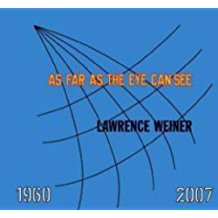As Far as the Eye Can See: Lawrence Weiner 1960-2007, editors Ann Goldstein and Donna de Salvo, 2008
As all good art (and art books), this volume which weighs in at 411 pages of dense prose and photographs of Weiner’s work, challenged me on several fronts: reading about a topic that is not intuitive for me (i.e. minimalist and conceptual art), trying to understand what ‘reading a book’ like this actually means, figuring out what the criteria are for including a book in my list. This book, the catalogue for a show of Weiner’s work at the Whitney and MOCA, LA, contains hundreds of photographs of his ‘language art’, books, videos, and representations on buildings, lighthouses, abdomens, manhole covers, etc as well as eight of the densest, most unreadable, art essays I’ve ever encountered. Suffice it to say that halfway through I gave up on the prose and focused on the photos. Weiner, born in 1948 in the Bronx, left NY for the West Coast in his teens and embarked without formal training on a very productive career of exploring the concepts of language, materials, objects, context, and time. His notion that the ‘conditions of a work of art’ are the basis of the work is built on the ‘irrevocable contingent relationship between the artwork and its context’. His three Statements of Intent first published in 1968 are a good summary of his work: “1. The artist may construct the piece 2. The piece may be fabricated 3. The piece need not be built. Each being equal and consistent with the intent of the artist, the decision as to condition rests with the receiver upon the occasion of receivership.” My interest in Weiner derives from his work in the bathroom of the Vogels’ apartment followed by his current language piece on the Greenway in Boston followed by finding this volume in the Krakow Gallery. Volumes could be written about his work, as seen in this current beautiful though unreadable book!



